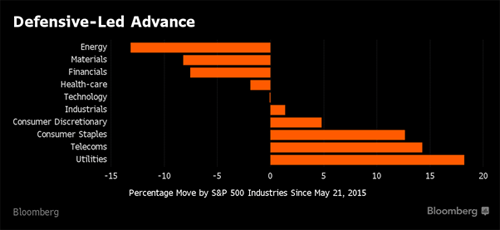 The S&P 500 made a new high in New York. It’s been 13 long months since the index made a new high. But it did so yesterday at 2,137. This seven year bull market may not be in rip-roaring health. But it’s not dead. At least not yet.
The S&P 500 made a new high in New York. It’s been 13 long months since the index made a new high. But it did so yesterday at 2,137. This seven year bull market may not be in rip-roaring health. But it’s not dead. At least not yet.
The S&P has been led higher by defensive stocks since May of last year. You could call it a grudging rally, where leadership has been handed over from growth and towards income, value, and safety. Is it a signal you can trust?
British investors certainly ought to have some exposure to foreign stocks. But which ones? American stocks? The S&P 500? Or what about high-yield bond exchange-traded funds?
In yet another interesting signal, the world’s second largest bond ETF took in a record $1.1 billion last Thursday, according to Bloomberg. The fund in question invests in dollar-denominated high-grade corporate debt from US blue chips. Why does that matter?
The ETF in question is one of the things you might buy if, say, central bank bond-buying programmes were driving down yields on government bonds and you were looking for a yield somewhere else (or front running other assets that benefit from central bank bond buying).
I would not call this investing. In the past, I’ve called it “liquidity surfing.” But it’s really just having a punt. You can use ETFs as a proxy for an asset class. This happened with the gold ETFs during the big run up in that asset. Many investors never intended to own physical gold. But they didn’t mind at all speculating on the price action.
All of that’s fine, of course. As long as you know your capital is at risk and that what you’re doing is speculating and not trading. But my point is similar to what I wrote yesterday: you’re probably taking on a lot more risk than you’re aware of by trying to get ahead of central banks. Bond ETFs make it easy to speculate on corporate bonds. But that’s not the same as investing – and correctly valuing – corporate bonds. Just remember that.
And don’t forget the Dutch!
The Netherlands joined the “minus yield” club yesterday when 10-year Dutch government bonds went negative. It wasn’t a big minus number, at -0.007%. But it’s the lowest yield on the 10-year since the Dutch have been keeping records. And they’ve been keeping records since 1517, which is exactly 499 years ago if you’re scoring at home.
Think about that. A 500-year low on Dutch government bonds. That tells you we really are living in an extraordinary financial time.
Now, let me remind you that the Japanese yen fell overnight. This, of course, is exactly what the Japanese policy makers want, although by now they may not even remember why (ostensibly to boost exports and corporate earnings for Japanese firms). But remember the point about inflation coming from deflation?
The spark that lights the fuse that blows up the bond market is a currency crisis. That’s the big risk now, with over $13 trillion worth of negative yielding government bonds. Everyone’s crowded into the same theatre because there’s room and it feels safe. But it’s not.
Yes, there is trouble in the Italian banking sector. And yes, I’m reading the same disturbing stories about Deutsche Bank’s derivatives exposure. But you can’t have the Greatest Depression Ever without a currency crisis. How might it happen?
Category: Market updates

